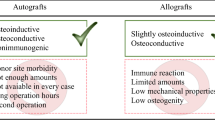Abstract
In this work, Arg-Gly-Asp (RGD) sequence containing peptide was immobilized on hydroxyapatite (HA) coatings through a chemical bonding approach in two steps, surface modification with 3-aminopropyltriethoxysilane (APTES) and RGD immobilization. The results indicate that RGD has been successfully immobilized on HA coatings. Comparing with physical adsorption coatings, the chemically bonded RGD on the coatings shows much better anti-wash-out ability. Since RGD is able to recognize cell-membrane integrins on biointerfaces, the present method will be an effective way to favor interaction of cells with HA coatings.



Similar content being viewed by others
References
Hench LL. Bioceramics: from concept to clinic. J Am Ceram Soc. 1991;74:1487–510.
Porter AE, Hobbs LW, Rosen VB, Spector M. The ultrastructure of the plasma-sprayed hydroxyapatite-bone interface predisposing to bone bonding. Biomaterials. 2002;23:725–33.
Chang CK, Wu JS, Mao DL, Ding CX. Mechanical and histological evaluation of hydroxyapatite-coated and noncoated Ti6Al4V implants in tibia bone. J Biomed Mater Res. 2001;56:17–23.
Sawyer AA, Weeks DM, Kelpke SS, McCracken MS, Bellis SL. Biomaterials. 2005;26:7046–56.
Bagno A, Piovan A, Dettin M, Chiarion A, Brun P, Gambaretto R, et al. Human osteoblast-like cell adhesion on titanium substrates covalently functionalized with synthetic peptides. Bone. 2007;40:693–9.
McAllister BS, Haghighat K. Bone augmentation techniques. J Periodontol. 2007;78:377–96.
Le GL, Soueidan A, Layrolle P, Amouriq Y. Surface treatments of titanium dental implants for rapid osseointegration. Dent Mater. 2007;23:844–54.
Nuttelman CR, Mortisen DJ, Henry SM, Anseth KS. Attachment of fibronectin to poly(vinyl alcohol) hydrogels promotes NIH3T3 cell adhesion, proliferation, and migration. J Biomed Mater Res. 2001;57:217–23.
Bhati RS, Mukherjee DP, McCarthy KJ, Rogers SH, Smith DF, Shalaby SW. The growth of chondrocytes into a fibronectin-coated biodegradable scaffold. J Biomed Mater Res. 2001;56:74–82.
Lutolf MP, Hubbell JA. Synthetic biomaterials as instructive extracellular microenvironments for morphogenesis in tissue engineering. Nat Biotechnol. 2005;23:47–55.
Hersel U, Dahmen C, Kessler H. RGD modified polymers: biomaterials for stimulated cell adhesion and beyond. Biomaterials. 2003;24:4385–415.
Ruoslahti E. RGD and other recognition sequences for integrins. Ann Rev Cell Dev Biol. 1996;12:697–715.
Pierschbacher MD, Ruoslahiti E. Nature. 1984;309:30.
Shin H, Jo S, Mikos AG. Review: biomimetic materials for tissue engineering. Biomaterials. 2003;24:4353–64.
Castel S, Pagan R, Mitjans F, Piulats J, Goodman S, Jonczyk A. RGD peptides and monoclonal antibodies, antagonists of alpha-v-integrin, enter the cells by independent endocytic pathways. Laboratory investigation. Lab Invest. 2001;81:1615–26.
Memmo LM, McKeown-Longo P. The alphavbeta5 integrin functions as an endocytic receptor for vitronectin. J Cell Sci. 1998;111:425–33.
Garcia AJ, Keselowsky BG. Biomimetic surfaces for control of cell adhesion to facilitate bone formation. Crit Rev Eukaryot Gene Express. 2002;12:151–62.
Weng WJ, Baptista JL. The preparation and characterization of hydroxyapatite coatings on Ti6Al4V alloy by a sol-gel method. J Am Ceram Soc. 1999;82:27–32.
Karakecili AG, Demirtas TT, Satriano C, Gümüsderelioglu M, Marletta G. Evaluation of L929 fibroblast attachment and proliferation on Arg-Gly-Asp-Ser (RGDS)-immobilized chitosan in serum-containing/serum-free cultures. J Biosci Bioeng. 2007;104:69–77.
Mouanda B, Viel P, Blanche C. Thin Solid Films. 1998;323:42.
Acknowledgements
This work is partly supported by Heilongjiang Provincial Science Foundation (Grant for Young Scholars, No. QCO7C38).
Author information
Authors and Affiliations
Corresponding author
Rights and permissions
About this article
Cite this article
Yang, C., Cheng, K., Weng, W. et al. Immobilization of RGD peptide on HA coating through a chemical bonding approach. J Mater Sci: Mater Med 20, 2349–2352 (2009). https://doi.org/10.1007/s10856-009-3794-1
Received:
Accepted:
Published:
Issue Date:
DOI: https://doi.org/10.1007/s10856-009-3794-1




